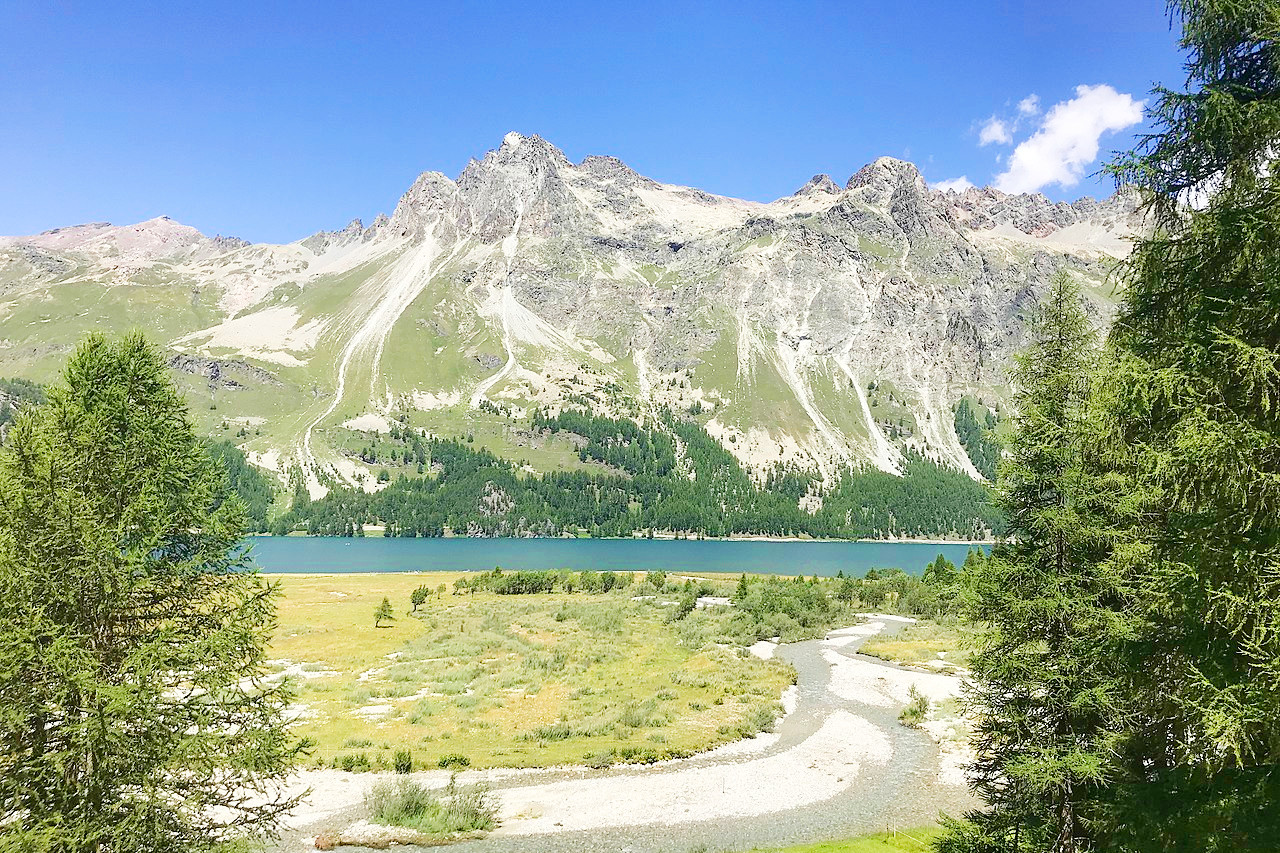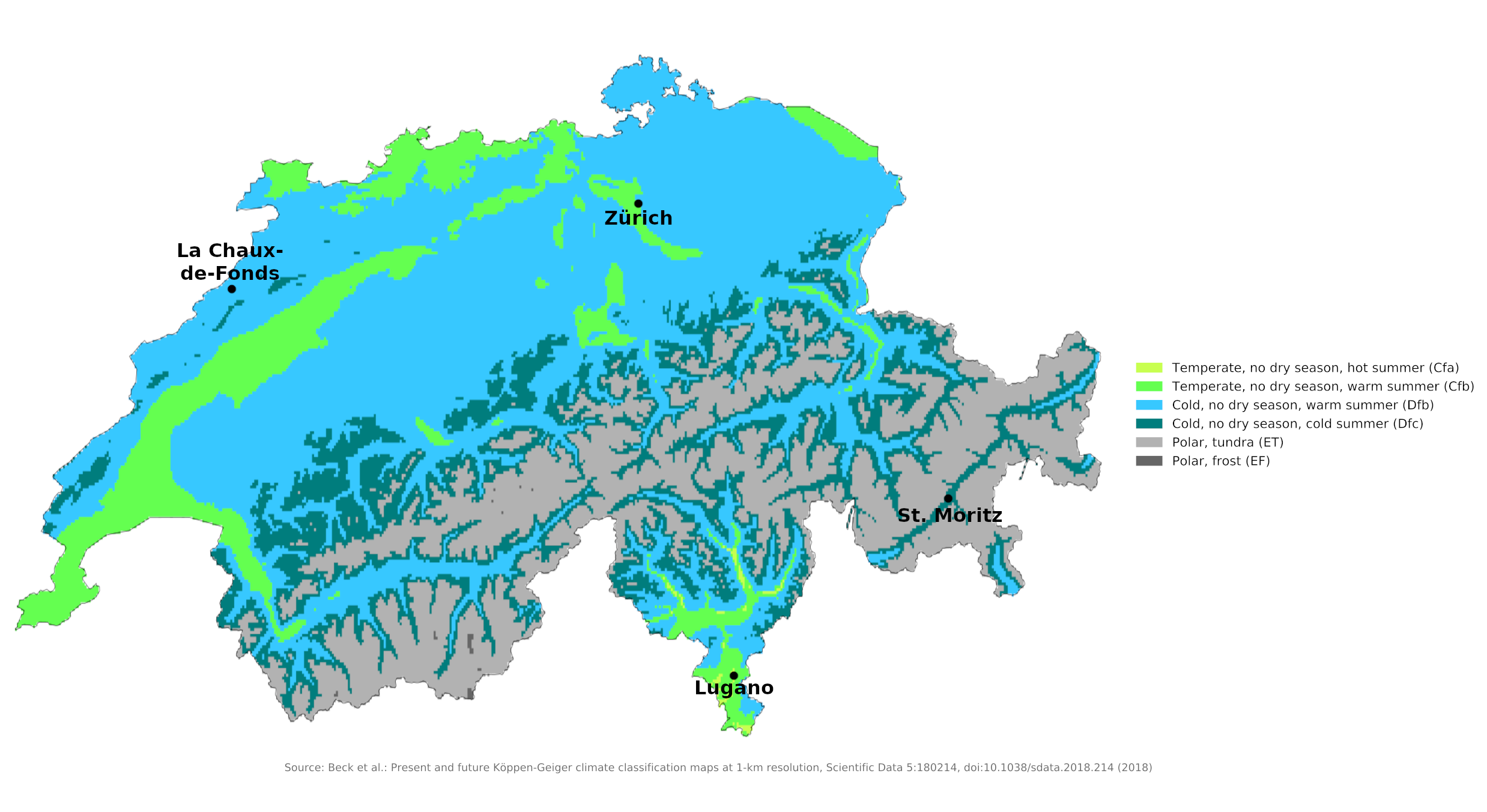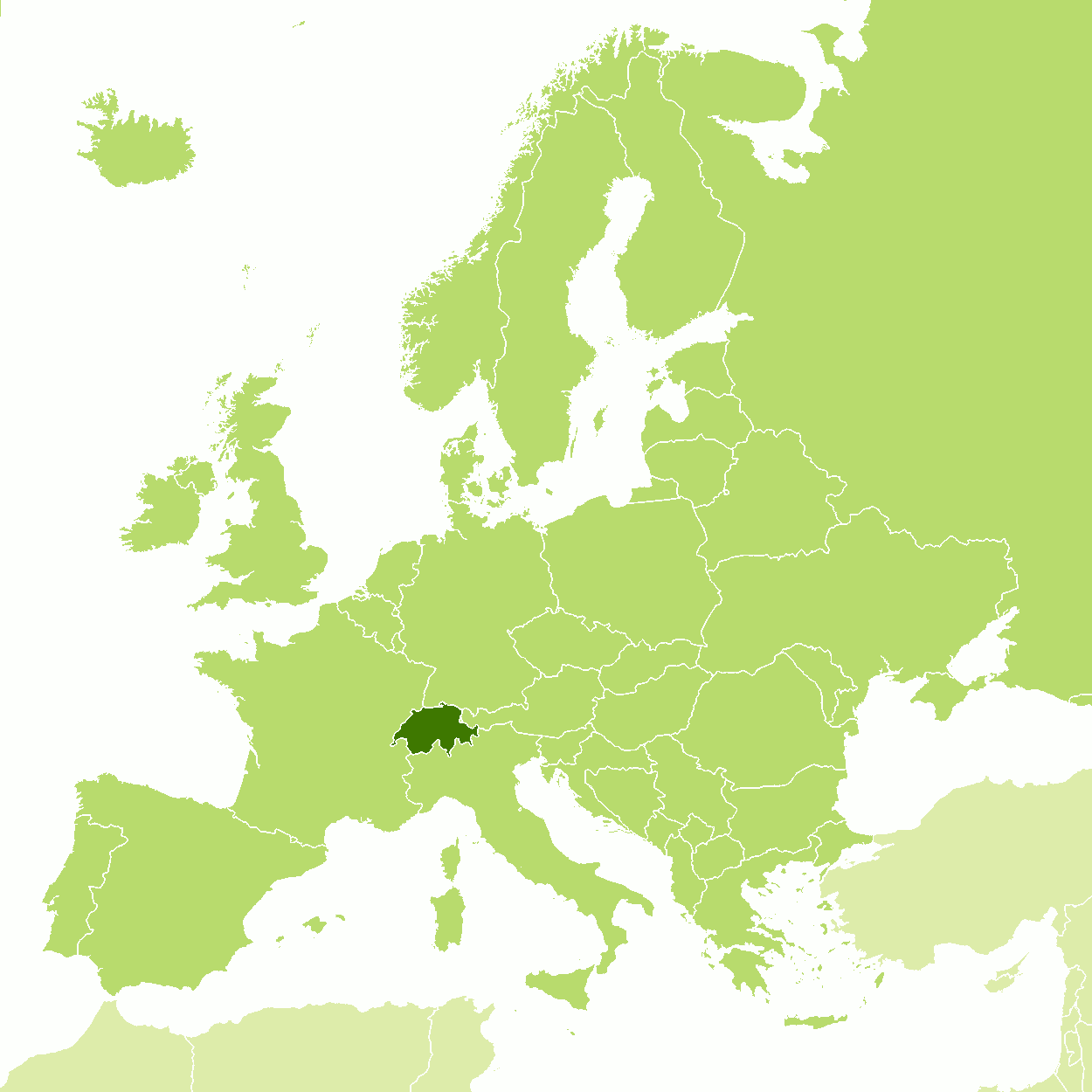The Climate of
Switzerland
 View towards Lake Sils, in Grisons
View towards Lake Sils, in Grisons
Climate Map
 Climate map of Switzerland
Climate map of Switzerland
What is the climate of Switzerland like?
Switzerland is a small, mountainous, landlocked country in Central Europe. It is bounded on the north by Germany, on the east by Liechtenstein and Austria, on the south by Italy, and on the west by France. Due to its large differences in altitude, it has a wide variety of climatic conditions. The higher peaks of the Alps rise to over 4,000 meters (13,000 feet) and are snow-capped all year round. At lower elevations in the Alpine valleys and midlands of Switzerland, summers can be quite warm, but this is the wettest season in Switzerland. Much of the summer precipitation is heavy and is often accompanied by violent thunderstorms.
Like other parts of west-central Europe, Switzerland is exposed to climatic influences from the Atlantic and from Eastern Europe, and the weather is changeable in every season. The most consistent weather occurs when the country is affected by an anticyclone. In summer this brings warm, sunny weather, but in winter it can bring either cold, sunny weather or easterly winds with cloudy skies. Midwinter is more likely than midsummer to be a period of stable weather.
The country can be divided into four climatic regions: Canton Ticino or extreme south, Alps, Central or Central Plateau and Jura mountains.
Canton Ticino
This small area around Lakes Maggiore and Lugano is the warmest part of the country in summer and winters are relatively mild with low temperatures. It lies south of the main Alpine ridges and is occasionally influenced by warmer Mediterranean air. Summers are more similar to those of the adjacent northern Italian plains, but are decidedly wet, with rain coming in torrential downpours. In calm weather it can be quite hot and sunny here. Prolonged frost is rare at low levels in winter. Lugano is representative of this area.
| Climate data for Lugano (1991–2020) | |||||||||||||
|---|---|---|---|---|---|---|---|---|---|---|---|---|---|
| Month | Jan | Feb | Mar | Apr | May | Jun | Jul | Aug | Sep | Oct | Nov | Dec | Year |
| Average high °C (°F) | 7.1 (44.8) | 9.0 (48.2) | 13.5 (56.3) | 16.7 (62.1) | 20.8 (69.4) | 24.9 (76.8) | 27.3 (81.1) | 26.8 (80.2) | 22.1 (71.8) | 16.9 (62.4) | 11.6 (52.9) | 7.7 (45.9) | 17.0 (62.6) |
| Daily mean °C (°F) | 3.8 (38.8) | 5.0 (41.0) | 8.9 (48.0) | 12.3 (54.1) | 16.3 (61.3) | 20.4 (68.7) | 22.6 (72.7) | 22.1 (71.8) | 17.9 (64.2) | 13.2 (55.8) | 8.4 (47.1) | 4.6 (40.3) | 13.0 (55.4) |
| Average low °C (°F) | 1.2 (34.2) | 1.9 (35.4) | 5.2 (41.4) | 8.5 (47.3) | 12.4 (54.3) | 16.1 (61.0) | 18.0 (64.4) | 17.8 (64.0) | 14.2 (57.6) | 10.2 (50.4) | 5.7 (42.3) | 2.0 (35.6) | 9.4 (48.9) |
| Average precipitation mm (inches) | 66 (2.6) | 61 (2.4) | 76 (3.0) | 138 (5.4) | 178 (7.0) | 172 (6.8) | 158 (6.2) | 158 (6.2) | 165 (6.5) | 150 (5.9) | 167 (6.6) | 80 (3.1) | 1,567 (61.7) |
| Average snowfall cm (inches) | 6 (2.4) | 5 (2.0) | 2 (0.8) | 0 (0) | 0 (0) | 0 (0) | 0 (0) | 0 (0) | 0 (0) | 0 (0) | 0 (0) | 9 (3.5) | 22 (8.7) |
| Source: MeteoSwiss | |||||||||||||
The Alps
Including Valais, Graubünden.
The Alps cover half of the country, stretching from Geneva to the Austrian border. There are big differences between the climate of the valleys and the higher mountains. In winter, the valleys are often cloudy and foggy with persistent frost. In contrast, when the weather is calm, the mountains are relatively sunny and daytime temperatures can feel quite warm. In winter, the climate in the winter sports resorts is more pleasant than in the valleys or on the central plateau. In summer, conditions can be exactly the opposite: mountains are shrouded in clouds during the day and valleys bask in warm, clear weather. The climate of St. Moritz represents this area.
When the weather is nice, a number of local winds occur in the Alps. In the large valleys, there is a tendency for the daytime breeze to go up the valley and a reverse valley wind to occur at night. In the vicinity of glaciers, this night wind can be very cold. a more widespread wind, the Föhn, can affect large parts of the Alps under certain meteorological conditions. It is a warm wind that brings air with very low relative humidity. Although it can blow in valleys on the south side of the Alps, it is stronger on the north side and blows particularly where valleys run south to north. It is most noticeable in late winter and spring and can melt snow very quickly. At higher altitudes, it can trigger dangerous avalanches, and at lower altitudes, the very dry air and strong winds increase the risk of fire for wooden buildings. When the föhn blows, the temperature can rise by up to 15° to 20°C (27° to 36°F) within an hour. Such states can last for two or three days.
| Climate data for St. Moritz (1991−2020) | |||||||||||||
|---|---|---|---|---|---|---|---|---|---|---|---|---|---|
| Month | Jan | Feb | Mar | Apr | May | Jun | Jul | Aug | Sep | Oct | Nov | Dec | Year |
| Average high °C (°F) | −1.3 (29.7) | 0.5 (32.9) | 4.0 (39.2) | 7.9 (46.2) | 12.9 (55.2) | 17.0 (62.6) | 19.3 (66.7) | 18.8 (65.8) | 14.6 (58.3) | 10.5 (50.9) | 4.1 (39.4) | −0.7 (30.7) | 9.0 (48.2) |
| Daily mean °C (°F) | −8.4 (16.9) | −7.1 (19.2) | −2.4 (27.7) | 1.9 (35.4) | 6.7 (44.1) | 10.5 (50.9) | 12.3 (54.1) | 11.8 (53.2) | 7.9 (46.2) | 3.6 (38.5) | −2.1 (28.2) | −7.0 (19.4) | 2.3 (36.1) |
| Average low °C (°F) | −15.8 (3.6) | −15.6 (3.9) | −9.6 (14.7) | −4.3 (24.3) | 0.1 (32.2) | 3.2 (37.8) | 4.7 (40.5) | 4.7 (40.5) | 1.3 (34.3) | −2.6 (27.3) | −7.8 (18.0) | −13.4 (7.9) | −4.6 (23.7) |
| Average precipitation mm (inches) | 29 (1.1) | 19 (0.7) | 24 (0.9) | 37 (1.5) | 67 (2.6) | 91 (3.6) | 87 (3.4) | 100 (3.9) | 73 (2.9) | 77 (3.0) | 70 (2.8) | 37 (1.5) | 710 (28.0) |
| Average snowfall cm (inches) | 51 (20) | 42 (17) | 30 (12) | 21 (8.3) | 4 (1.6) | 0 (0) | 0 (0) | 0 (0) | 2 (0.8) | 12 (4.7) | 40 (16) | 52 (20) | 254 (100) |
| Source: MeteoSwiss | |||||||||||||
The Central Plateau
Including St Gallen, Zürich, Lucerne, Solothurn, Basel, Bern, Fribourg, Vaud, Genève.
The Central Plateau, or 'Mittelland', is the lowest part of the country and stretches from Lake Geneva to Lake Constance. All major cities in Switzerland and the majority of the population are here. Winters are generally cold with much persistent low cloud and fog. The conditions are very similar to those in the deeper valleys of the Alps. Severe winters with frequent snowfall can lead to several weeks of frost. Snow is common in milder and changeable winters. Summers are generally warm but rather wet. Summers can be vary from year to year in terms of cloud amount and number of rainy days. During wet periods in summer, rain can be heavy and long-lasting. The climate of Zurich is representative of this area.
| Climate data for Zürich (1991–2020) | |||||||||||||
|---|---|---|---|---|---|---|---|---|---|---|---|---|---|
| Month | Jan | Feb | Mar | Apr | May | Jun | Jul | Aug | Sep | Oct | Nov | Dec | Year |
| Average high °C (°F) | 3.5 (38.3) | 5.2 (41.4) | 10.2 (50.4) | 14.8 (58.6) | 18.8 (65.8) | 22.4 (72.3) | 24.3 (75.7) | 23.9 (75.0) | 19.1 (66.4) | 13.8 (56.8) | 7.6 (45.7) | 4.0 (39.2) | 14.0 (57.2) |
| Daily mean °C (°F) | 0.9 (33.6) | 1.8 (35.2) | 5.8 (42.4) | 9.6 (49.3) | 13.6 (56.5) | 17.1 (62.8) | 19.0 (66.2) | 18.6 (65.5) | 14.4 (57.9) | 10.0 (50.0) | 4.9 (40.8) | 1.7 (35.1) | 9.8 (49.6) |
| Average low °C (°F) | −1.4 (29.5) | −1.2 (29.8) | 1.9 (35.4) | 5.1 (41.2) | 9.0 (48.2) | 12.6 (54.7) | 14.4 (57.9) | 14.3 (57.7) | 10.7 (51.3) | 7.1 (44.8) | 2.5 (36.5) | −0.5 (31.1) | 6.2 (43.2) |
| Average precipitation mm (inches) | 63 (2.5) | 60 (2.4) | 71 (2.8) | 80 (3.1) | 128 (5.0) | 128 (5.0) | 126 (5.0) | 119 (4.7) | 87 (3.4) | 85 (3.3) | 76 (3.0) | 83 (3.3) | 1,108 (43.6) |
| Average snowfall cm (inches) | 14 (5.5) | 18 (7.1) | 10 (3.9) | 2 (0.8) | 0 (0) | 0 (0) | 0 (0) | 0 (0) | 0 (0) | 2 (0.8) | 7 (2.8) | 19 (7.5) | 72 (28) |
| Source: MeteoSwiss | |||||||||||||
The Jura Mountains
Including Neuchätel and Jura.
This small, narrow part of Switzerland stretches from Basel to Geneva along the French border. The Jura rises to less than half the height of the Alps, but the valleys are narrow and the ridges steep. This area is slightly wetter than the Swiss Mittelland and in winter the mountains carry snow for a long time. In some closed valleys, winter temperatures can sometimes drop very low as cold air drains to the valley floor. Summers are similar to those on the Swiss Mittelland, but tend to be cloudy and wetter. The climate of La Chaux-de-Fonds is representative of this area
| Climate data for La Chaux-de-Fonds (1991–2020) | |||||||||||||
|---|---|---|---|---|---|---|---|---|---|---|---|---|---|
| Month | Jan | Feb | Mar | Apr | May | Jun | Jul | Aug | Sep | Oct | Nov | Dec | Year |
| Average high °C (°F) | 3.0 (37.4) | 3.6 (38.5) | 7.1 (44.8) | 11.0 (51.8) | 15.0 (59.0) | 18.9 (66.0) | 20.8 (69.4) | 20.7 (69.3) | 16.6 (61.9) | 12.8 (55.0) | 7.2 (45.0) | 3.8 (38.8) | 11.7 (53.1) |
| Daily mean °C (°F) | −1.0 (30.2) | −0.7 (30.7) | 2.6 (36.7) | 6.1 (43.0) | 10.2 (50.4) | 13.8 (56.8) | 15.6 (60.1) | 15.4 (59.7) | 11.5 (52.7) | 8.0 (46.4) | 3.1 (37.6) | −0.1 (31.8) | 7.0 (44.6) |
| Average low °C (°F) | −5.4 (22.3) | −5.4 (22.3) | −2.1 (28.2) | 1.1 (34.0) | 4.9 (40.8) | 8.5 (47.3) | 10.2 (50.4) | 9.9 (49.8) | 6.7 (44.1) | 3.4 (38.1) | −1.1 (30.0) | −4.1 (24.6) | 2.2 (36.0) |
| Average precipitation mm (inches) | 107 (4.2) | 93 (3.7) | 99 (3.9) | 96 (3.8) | 131 (5.2) | 119 (4.7) | 131 (5.2) | 131 (5.2) | 114 (4.5) | 117 (4.6) | 118 (4.6) | 132 (5.2) | 1,389 (54.7) |
| Average snowfall cm (inches) | 54 (21) | 61 (24) | 36 (14) | 13 (5.1) | 1 (0.4) | 0 (0) | 0 (0) | 0 (0) | 0 (0) | 3 (1.2) | 29 (11) | 56 (22) | 253 (100) |
| Source: MeteoSwiss | |||||||||||||
When is the best time to visit Switzerland?
It gets very cold in the mountain areas, with much snow. In the cities, the summer temperature seldom gets very hot, and humidity is low. The clear air and lack of wind make even the mountain areas pleasant even in winter. For winter sports, the best time to go is between December and the end of April.
References
- E. A. Pearce, Charles Gordon Smith, (1990) The Hutchinson World Weather Guide, John Murray Press. ISBN 1859863426
- Timothy L. Gall, (ed.), (2003), Worldmark Encyclopedia of the Nations, Eleventh Edition, Thomson Gale
- Hugh Chisholm, (ed.), (1911), Encyclopædia Britannica, Eleventh edition, Cambridge University Press
The Climate of
Switzerland

In summary:
The climate of Switzerland is in a transitional zone, subject to Atlantic, Arctic, continental, and Mediterranean influences. The areas to the west and north of the Alps have a cool, rainy climate, with winter averages near or below freezing and summer temperatures seldom above 24°C (75°F). South of the Alps, the canton of Ticino has a warm, moist, Mediterranean climate, and frost is almost unknown. The climate of the Alps ranges from sub-alpine to polar.
Rainfall increases with altitude, ranging from 530 mm (21 in) in the Rhone Valley to 1600 mm (62 in) in Ticino. Areas that are located near each other but have sharply contrasting elevations can also have sharp differences in rainfall. At Alpine elevations of greater than 3,500 m (11,500 ft), all precipitation falls as snow.